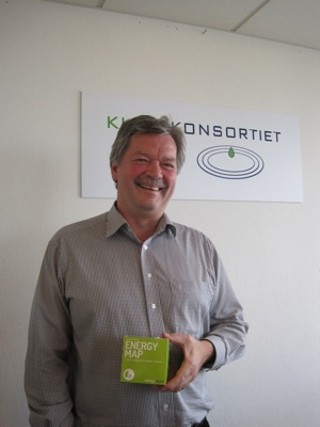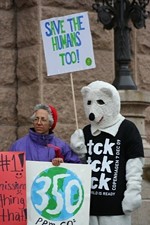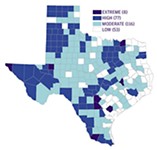Climate Consortium Denmark
Learning from Copenhagen, Post #4
By Katherine Gregor, 1:25PM, Mon. Oct. 5, 2009

Given Austin’s aspirations to market itself as a “Clean Energy Capital” for economic development, it would do well to closely study and follow the related example of Denmark. This morning Finn Mortensen, executive director of Climate Consortium Denmark, told us how and why the public-private “cleantech” consortium was organized.
True, they’re a nation and we’re a city. But they’re dinky (5 million people or so) and we’re big as Texas, right?
When Copenhagen was named host city for COP15, coming up in December, Denmark saw a golden opportunity to promote its own clean/green companies and solutions world-wide. (The same thinking underlies hosting the Olympics – another decision made here in Copenhagen this weekend.)
Now, ordinarily one is entitled to be dubious, even cynical about such profit-oriented opportunism. But in the case of climate action, it’s essential that cities, nations, business groups, and major corporations clearly see how they can cash in on a global shift from fossil fuels to renewable energy. Profit = good! If Denmark can benefit economically from leading the pack, and model that for the rest of the watching world – then more (wind) power to them.
Mortensen emphasized the importance for developing countries of Denmark’s positive example: Steady economic growth can go hand-in-hand with energy-use reductions. Denmark’s GDP has increased by 75% since the early 1970s, when the shift began here. (Remember the Seventies oil crisis? Unlike the U.S., Denmark learned its energy-independence lesson the first time.) Yet Danish energy consumption has remained constant – and shifted to 20% wind power.
“The Climate Change Conference in Copenhagen in December 2009 is an obvious opportunity to show the world that in Denmark we have reduced CO2 emissions and stabilized our energy consumption while at the same time creating economic growth,” explained Lene Espersen, Denmark’s minister for economic and business affairs. “It is this story and many other positive stories about the Danish corporate sector that Climate Consortium Denmark will help communicate to the rest of the world.”
Denmark has no dirty-coal or oil-industry jobs to speak of, Mortensen noted. So unlike Texas, it has enormous political will (i.e., everything to gain economically) for growing green jobs. Clean energy now accounts for 30,000-40,000 jobs here; projections show that number can triple within 10 years, if they grow the economic sector thoughtfully and properly.
Denmark will run out of its own natural gas and oil within 15 years, too; they have to ship in dirty coal by sea from Australia. But there’s plenty of wind right here at home.
So in pursuing green jobs for Austin, the Chamber of Commerce, city departments and council, and the Pecan Street Project (our local public-private consortium) might take note of how it’s being done in Denmark. CCD was established in February 2008 to strengthen international “awareness of the competences and solutions of Danish businesses, industries and universities in cleantech.” Its members have contributed about $10 million to fund CCD’s work.
Imagine if we had even a tenth of that budget to promote cleantech in Austin! (That was budgeted just from inception through May 2010; today it was announced CCD will continue for another 3-5 years at least.) The partners include: the Confederation of Danish Industry, the Danish Construction Association, the Danish Energy Association, the Danish Agriculture & Food Council, and the Danish Wind Industry Association, plus the Marketing Denmark Fund and the Danish state. Together the five business groups represent nearly all national commercial interests in play. Tasked with infrastructure and supply-and-demand issues is Energinet; PSP folks should check it out at www.energinet.dk.
The Danish public loves all of this, too, especially when the CCD’s handsome patron – H.R.H. Crown Prince Frederik of Denmark – shows up for events and awards ceremonies. If only Austin had a charismatic prince to lead the cause! (Well, we do have Brewster McCracken.)
While the Consortium’s mission is commercial, it works closely with the Danish government on promoting a substantive agreement at COP15. The partner companies have a big stake in climate action succeeding, as they are developing the products, services, and solutions whose market will explode as the world becomes more energy efficient. To reverse global warming, that’s the side Big Business needs to be on. The national goal here now is to become completely free of fossil fuels by 2050, running 50% on homegrown wind power. How to get there from here? A “how to” report and road map is due from the Danish Commission on Climate Change Policy by the end of 2010. Its work also will reflect the European Union 2050 goal for developed countries, to collectively reduce their emissions of greenhouse gases by 60% to 80%.
If you’ve read this far, check out CCD’s extremely cool marketing tool: www.energymap.dk.
The website is a map of Denmark that shows all of its cleantech-related companies, each as colorful dots embedded with visual, easy-to-access information about related technologies, projects, solutions, cases, and events. You can read about and directly contact the Danish companies and organizations involved. It’s a GoogleMap-based tool that is a blast to click around - Austin should have one of these! Amazing what a $10 million marketing budget can buy.
Got something to say on the subject? Send a letter to the editor.
A note to readers: Bold and uncensored, The Austin Chronicle has been Austin’s independent news source for over 40 years, expressing the community’s political and environmental concerns and supporting its active cultural scene. Now more than ever, we need your support to continue supplying Austin with independent, free press. If real news is important to you, please consider making a donation of $5, $10 or whatever you can afford, to help keep our journalism on stands.










